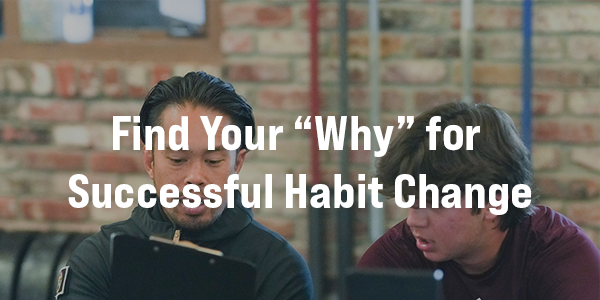We hope you have had a wonderful start to 2023, set some big objectives, and are working towards fulfilling them. If you’re not quite sure where to start, you’re certainly not alone. In fact, most people abandon their resolutions by the second Friday in January, which is now infamously known as National Quitters day. While this phenomenon is rooted in a very complex behavioral challenge, there is potential for tremendous personal growth when the right strategies are implemented. Here we will attempt to provide a framework from which to start and what to focus on to be successful.
Why do people quit?
Come January 1st, thoughts of audacious goals fill our bodies and minds with energy. It’s a fresh slate, now’s the time to finally get in shape, eat better, and save money! This feels great at first, but the drive quickly wanes as life refuses to slow down while familiar patterns take hold. You can think of motivation like riding a bike up twin peaks. During the initial hype phase, energy output and motivation is sky high. Once we reach the summit we enter the honeymoon phase, coasting here until we suddenly plummet down the other side and into the pit.
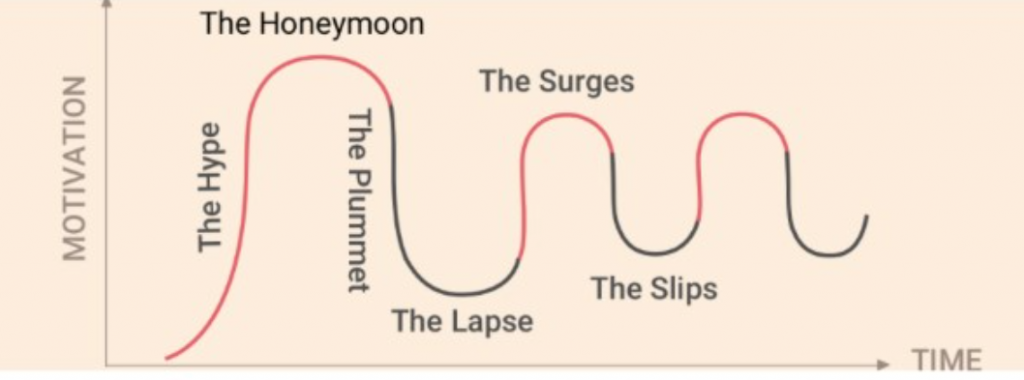
There are many reasons for this phenomenon. Of the top reasons cited, 35% of people attribute losing motivation as the top reason for giving up, followed by being too busy (19%) and changing their goals and priorities (18%). However, these vague reasons don’t tell the whole story. In reality, people often have no plan or strategy in place to accomplish their objectives. Add a static environment and lack of a support system to stay accountable and you have a recipe for failure. In order to get out of the pit, or avoid it altogether, it is critical to think about what small lifestyle changes are essential for making sustainable progress.
Focus on Small Changes
People tend to think that massive success requires massive action, which often equates to putting excess pressure on themselves. However, if you can get just 1% better each day for a year, you will end up 37x better by the end of the year. Unfortunately, small daily improvements tend to go unnoticed. If you go to the gym three times the first week of January, you are not in much better shape than when you started. If you go to the gym three times a week consistently for the whole year, you will definitely have made gains in your strength, muscle, and cardiovascular health.
When starting out, take your time identifying what objectives are most important to you. One objective is best, although 2-3 are possible. The more you create the more distraction there will be from the primary objective. The best objectives are S.M.A.R.T, – Specific, Measurable, Achievable, Relevant, and Time Bound. More on this concept later. Second, use some method to track your habits related to that objective. Technology like the Oura ring or My Fitness Pal can be powerful tools to make tracking essential data easy. A good habit tracking app should allow you to set targets for the month, track your progress, and provide some flexibility over when and how you track your habits.
Identify Obstacles
Next identify what is going to be your potential point of failure. What has stopped you in the past? It could be time constraints, tendency toward injury, or a busy travel schedule. What are the non-negotiables in your life? It could be time with family, getting to the office by 7am, or golf on Sundays. Honor these activities and work with them as opposed to against them. The process of behavior modification can seem daunting at first, but by having a clear vision of where you want to go, the small daily habits required of you for success will become obvious.
Become the Architect of Your Environment
Motivation is overrated; environment matters more. In his bestselling book Atomic Habits, James Clear states “People often choose products not based on what they are, but where they are,” The environment is constantly giving us cues to initiate certain behaviors. If you are trying to make better food choices, but your office break room always has donuts and bagels on the table, you will find it very difficult not to take one from time to time. This is why grocery stores put items at the end cap of aisles to sell them quickly. Utilize this strategy in your own life by being the architect of your environment. If you wish to go to the gym first thing in the morning, lay out your gym clothes somewhere in plain sight the night before. When you wake up and see them your first thought will be to get ready for the gym. You have just given yourself a trigger to engage in a desired behavior. Keeping up with this habit will soon start to create a ritual before bed to ensure you go to the gym the next day. Not only will you be creating easy and satisfying habits, but you will accomplish something difficult early the next day. This can set the tone for your entire day to be more productive.
Make it S.M.A.R.T
The popular acronym SMART is widely used to approach behavior change with a systematic approach. Before you begin taking on a new objective, ask yourself – is it Specific, Measurable, Achievable, Relevant and Time-Bound? It’s easy to say vague things like “I want to lose weight,” but how much weight? Are you giving yourself a realistic time-frame? Utilizing this tool can highlight potential problem areas before progress is derailed. For example, if you plan to participate in dry January, but you have a vacation planned that month, you will need a strategy for making good choices during your vacation. If not, you will likely default to old habits. Take SMART seriously and arm yourself with the small details that make a huge difference to adherence.
The Accountability Partner
Most people would think of an accountability partner as a supportive friend who will be there to pat you on the back when you’re doing a good job. While we do need encouragement and support in the process of behavior change, it is sometimes not enough. When there is an immediate reward for performing a desired action or habit, there tends to be a high correlation that the behavior will be repeated. The opposite is also true. Bad habits that have an immediate unsatisfying consequence tend to resolve quickly. One way to utilize this concept is to find an accountability partner. This could be a close friend, family member, or a challenge to participate in with a community to report to. Knowing that someone is watching can be a powerful motivator because it feels terrible to not keep a promise to yourself and someone close to you. However, a good accountability partner will be there to provide support when necessary. This can feel like we are not alone in the process and be incredibly rewarding.
In Conclusion
It’s easy to set lofty goals, but recognize that you need to prioritize what you really want and have a plan of action. Understand that motivation will come in waves and require you to stay organized and persistent. Break your objectives down into small behaviors that you will need to accomplish in order to make some progress each day. Lastly, seek out an accountability partner who can help keep you on track.
Wanting to make a change and actually making it a priority are very different mindsets. The behavior change process, when done with a carefully thought out vision, often leads to a tremendous shift in identity. This beautiful transformation is the result of digging deep and finding your “why”. Why do you want to change? Think about how change will positively impact those around you and those who love you. Keep your sights locked in on your “why” and have an amazing 2023!
Below you will find links to some popular apps that are often used at FiT:
Sleep
Blood Sugar Tracking
Food
Post References:
https://blog.nasm.org/setting-smart-fitness-goals
https://zapier.com/blog/best-habit-tracker-app/
Kristin Pampeyan
Trainer
Spirit Animal: Bumblebee
What I love about FiT: That everyone is invested in the community whether it’s by hosting additional activities or sharing knowledge. It’s all to make each other better and help out the clients.
Favorite sports: Swimming and Softball
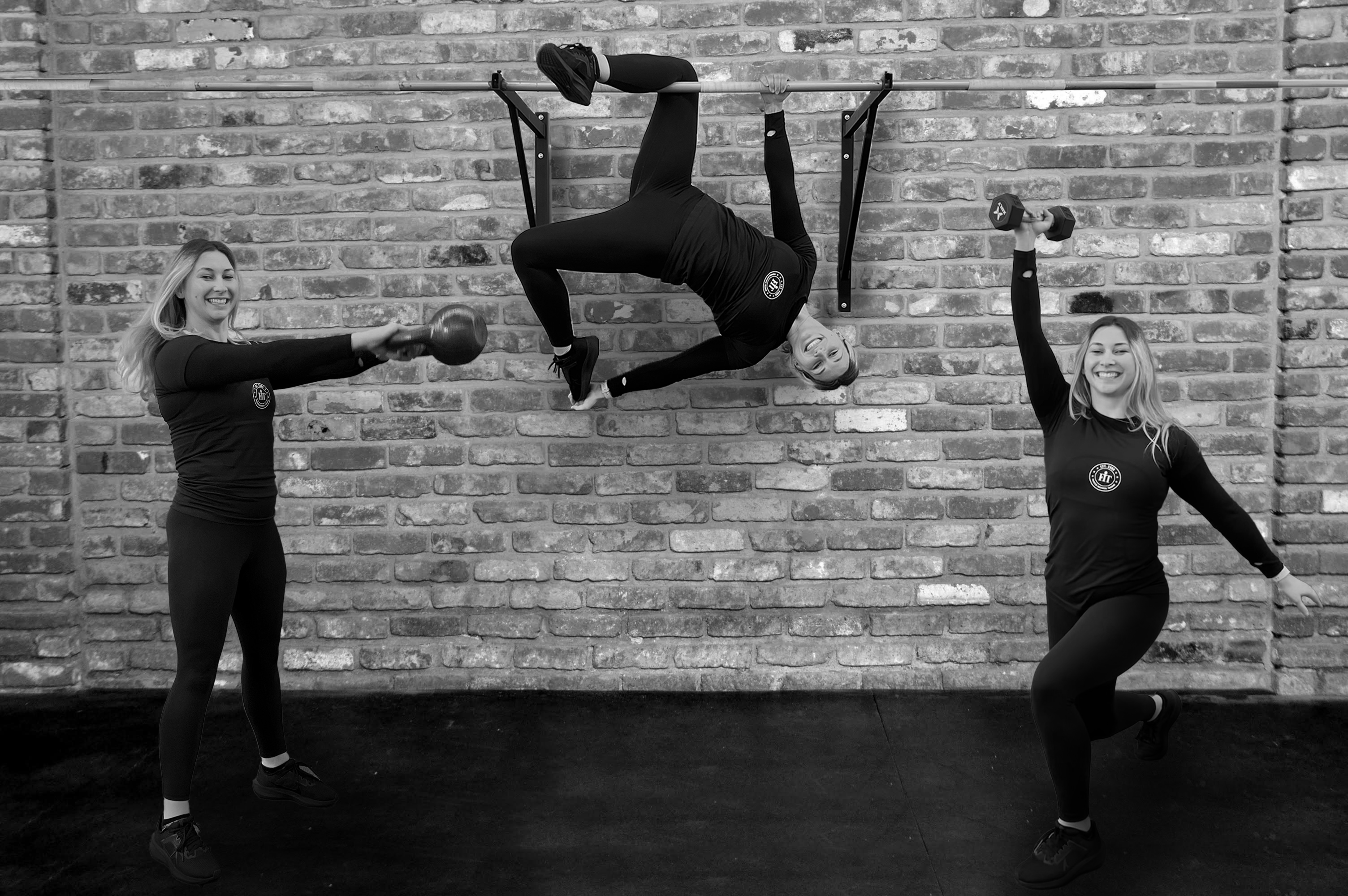
Dae-Von Bishop
All the way from East Palo Alto, Dae-Von was an avid basketball player and fan since the age of 10. From Eastside College Prep to Sonoma State to Foothill where he received his AA in psychology. Dae-Von developed a passion for training and helping others stay active and healthy after a bad ankle sprain in high school that occurred during the basketball season. Dae-Von received training the following summer at The Riekes Center, leading him to have a healthy senior year season as well as making 2nd team all league.This is what inspired him to become a trainer and help other athletes stay in great shape. At 20 years old, Dae-Von’s personal training journey began at The Riekes Center, and he hasn’t looked back since.
Dae-Von holds certifications in personal training through NASM, archery, as well as speed and agility and weightlifting both through NSPA. He even will do some basketball skill development on the side for young hoopers. His goal is to help people stay as fit and active as possible with little to no complications. I love training groups of athletes in either middle or high school. Those age groups tend to be the best time for athletes to get faster and stronger, as well as they begin to understand movement patterns which allow them to perform at an elite level. There is also a natural competitive aspect of training in groups that pushes kids to go harder during drills.
In his free time, you can find Dae-Von shooting hoops, working out, playing video games, spending time with friends, trying new foods(as long as there is no avocado), or hanging out with his frenchie, Trouble.
- Personal Trainer (NASM)
- Certified Speed and Agility Coach (National Sports Performance Association)
- Certified Weightlifting Coach (National Sports Performance Association)
- Archery Lvl. 2 (USA Archery)

Megan Justice
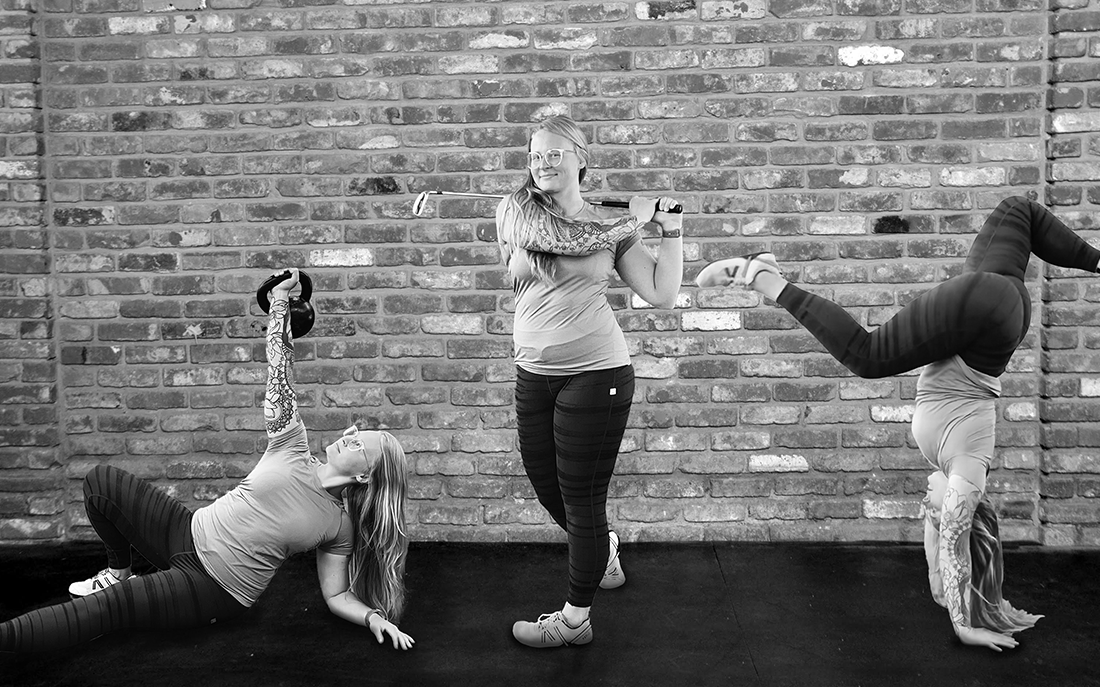
Jon Angeles

James Frederick
Trainer
Spirit Animal: Orca
Contact
- Dynamic Variable Resistance Training (DVRT) Level 1 Certification
- Certificate in Nutrition (FAB Academy)
- Certificate in Applied Stretching Theory and Practice (FTP)
- NASM-CPT
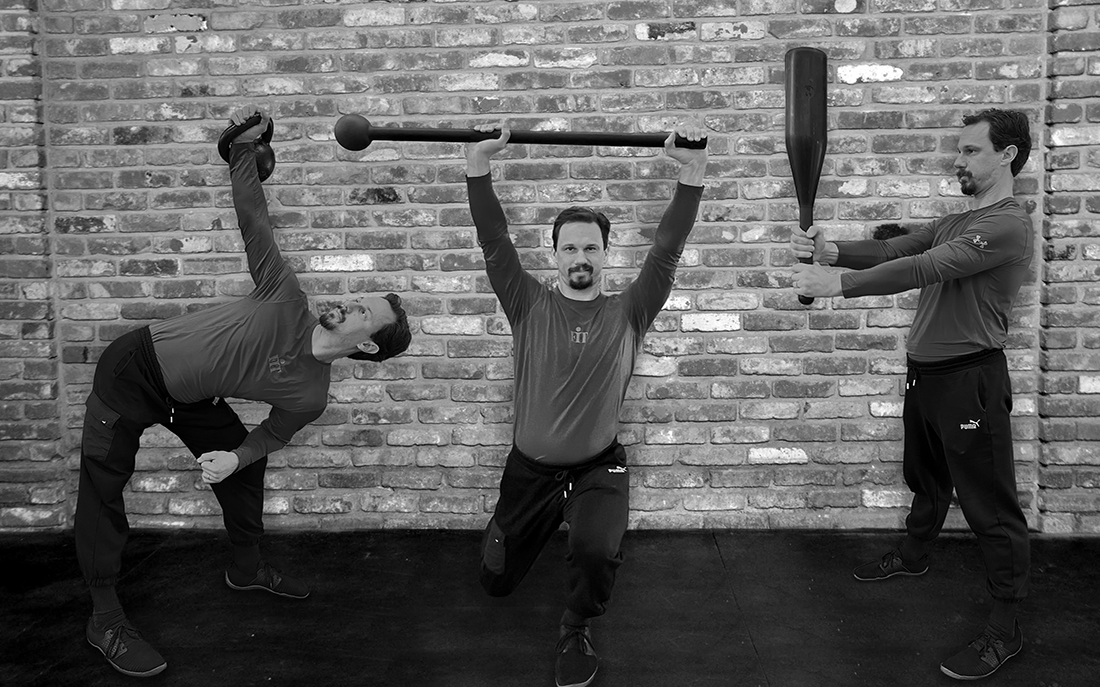
Jake Verhulp

Hannah Golden

Serena Earwicker
Operations Manager
Spirit Animal: Owl
Contact
Serena manages the day-to-day operations at FIT. If you need help with something apart from training, she is the one to get it done.
Outside of FIT you will find Serena hiking, biking and playing at the beach with her family.
What I love about FiT: FiT is welcoming and supportive to all. It feels like a hug, a sweaty one. Haha
Favorite sports: Anything I get to see live! Love the energy.
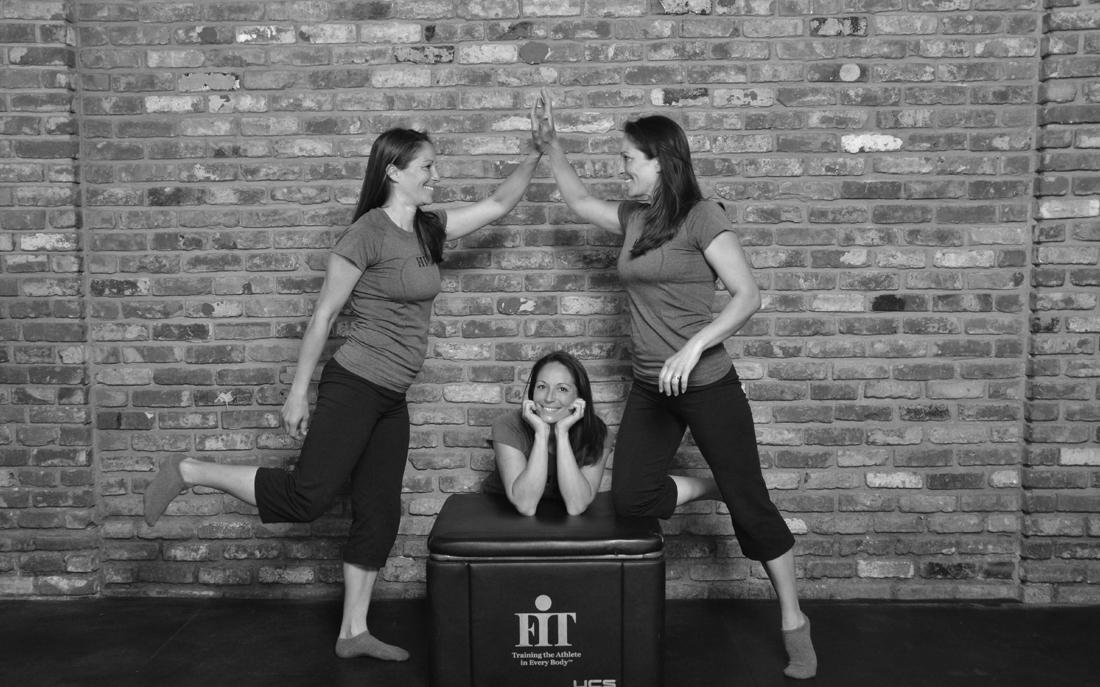
Tracey Downing
Owner
Spirit Animal: Owl
Contact
Tracey Downing has dedicated her life’s journey to empowering individuals to discover newfound confidence in their physical abilities and take command of their long-term well-being. Together with her husband, Thom, she established FiT, a health promotion company, in 2000, impacting numerous lives by guiding them towards positive lifestyle shifts and instilling the importance of prioritizing their health.
Her academic journey at the University of Michigan, where she graduated with a degree in Kinesiology, was complemented by a vibrant period of exploration. Tracey’s adventures took her across the globe to live in places like New Zealand, Ireland, and Scotland. These enriching experiences allowed her to indulge her passion for travel while simultaneously nurturing her professional growth, with roles in clinical and professional sports settings.
Beyond her entrepreneurial pursuits, Tracey treasures her role as a mother to two wonderful children. Outside of her business endeavors, she has completed an Ironman Triathlete, a testament to her unwavering determination, had the incredible honor of being an Olympic Torch Bearer for the Salt Lake City Olympics, and is a 20 year survivor of breast cancer.
In Tracey’s world, fostering physical wellness is not just a profession; it’s a lifelong vocation driven by a genuine desire to inspire and uplift others on their unique journeys toward lasting health and vitality.
What I love about FiT: Seeing people change: doing more than they thought they could, learning more than they thought they would, and showing up to make themselves better.
Favorite sports: Playing tennis and watching anything my kids are playing

Brett Lando
Physical Therapist
Spirit Animal: Cheetah
Contact
Brett grew up in San Francisco and attended St. Ignatius College Preparatory where he ran cross-country and track and field. After graduating from high school, he attended the University of California, Irvine where he earned his Bachelor’s degree in Biology. While at UC Irvine he competed on the cycling team in road and cyclo-cross races and helped manage the campus bike shop.
Brett graduated with his Doctorate of Physical Therapy from the University of California San Francisco/San Francisco State University. He is a graduate of Agile’s yearlong Orthopedic Residency, is a Board Certified Orthopedic Clinical Specialist and most recently completed a yearlong Fellowship in sports and manual therapy.
In his free time, Brett enjoys road cycling, the occasional triathlon, alpine skiing, surfing, backpacking, traveling and cooking with his wife.
What I love about FiT: The TEAM, Learning new exercises from the trainers, and a variety of fun, innovative exercise equipment.
Favorite sports: Cycling, Skiing, Surfing
- Doctor of Physical Therapy
- Board- Certified Clinical Specialist in Orthopaedic Physical Therapy
- Fellow of the American Academy of Orthopaedic Manual Physical Therapists
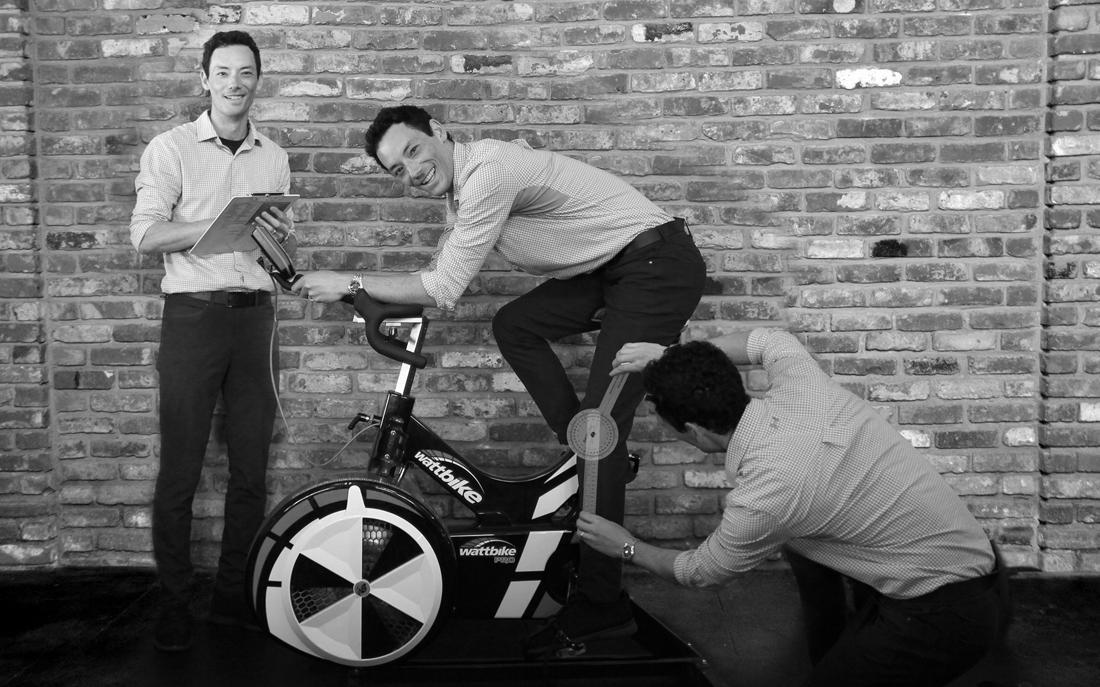
Kendra Wagers
Massage Therapist
Contact
Kendra Wagers has been a Massage Therapist since 2001. A native to California, she began her massage career in the Central valley working with various injury and chronic pain methods under experienced Chiropractors and physical therapists. In 2003 she relocated to Las Vegas, NV to attend the Nevada School of Massage Therapy’s accredited massage program which led to obtaining her National certification from NCBTMB. For over 13 years she worked as a licensed massage therapist in Nevada, including employment at top rated Spas on the Las Vegas strip. Receiving training in various modalities over the years including; Hawaiian Lomilomi, Thai, Sports and Shiatsu. In January of 2017 Kendra decided to return to California and is currently enrolled in the Traditional Chinese Medicine program at Five Branches University, furthering her education on overall health and wellness. With more than 17 years of experience and over 1500 hours in training Kendra has been able to hone in on her passion for healing while combining multiple techniques to provide a personalized and detailed massage to every guest. Her serene approach combined with her roots in structural techniques, offers harmony, balance, and ease to injuries or everyday stresses.
CA State Massage License #73011
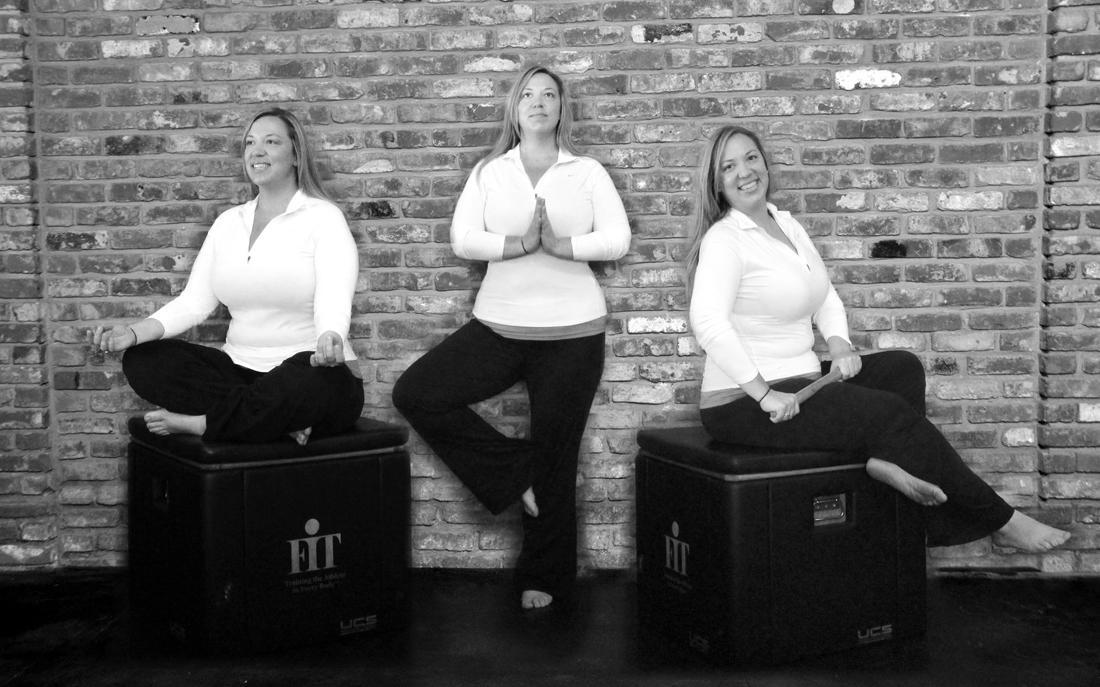
Katie Deangelis
- American Council on Exercise
- Crossfit Level One
- NSCA Certified Strength and Conditioning Specialist, In Progress
- Precision Nutrition Level 1 Certified, In Progress

Kevin Martin
Strength and Wellness Coach
Personal Trainer
Certified Strength and Conditioning Specialist
OPEX CCP
Spirit Animal: The Lorax
Contact
Kevin graduated from Trinity University in San Antonio, TX with a B.S. in Business Administration with a focus in marketing. As a student, Kevin was a five-time conference champion in the 1-meter and 3-meter springboard diving events. He is a Certified Strength and Conditioning Specialist with the National Strength and Conditioning Association.
He has a particular passion for rehabilitation and improving overall functional status. He enjoys identifying and correcting areas of the body that are not operating at their full potential so that everyone can live life to the fullest!
Kevin has completed a full ironman, multiple 70.3 triathlons, 2 full marathons, as well as several shorter distance triathlons and road races. In addition to triathlon, he has a background in gymnastics, swimming, diving, and volleyball. He enjoys helping everyone find the athlete within themselves and find a love for movement and exercise.
When Kevin isn’t training at FiT or exercising, he enjoys cooking, surfing, hiking, and spending time with his wife and dog. He especially loves being a father his young daughter Mayley.
What I love about FiT: Community, Hard work, Supportive, Fun
Favorite sport: Volleyball, Surfing, Diving, Running, Cycling, Swimming (triathlon), Weight lifting. I love watching all sports.
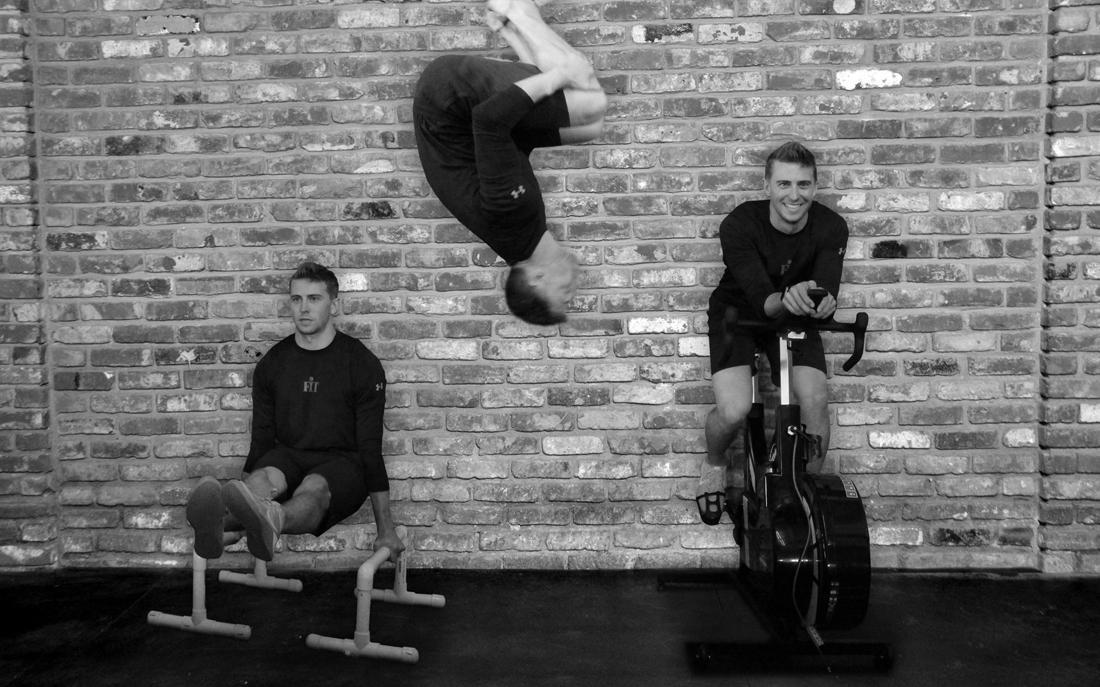
Tyler Pinkney
- 4 years of collegiate coaching experience
- Former Division I Athlete
- Assisted multiple athletes to the professional level
- Certified Strength and Conditioning Specialist, National Strength and
- Conditioning Association
- Basic Olympic Lifting Certification, Totten Training Systems
- Bachelors of Science in Psychology
- Masters of Education in Coaching, Sport, Recreation, and Fitness
- Administration

Juliana Oliveira
Trainer
Spirit Animal: Dolphin
Contact
What I love about FiT: I love the schedule flexibility.
Favorite sports: Snorkeling and swimming
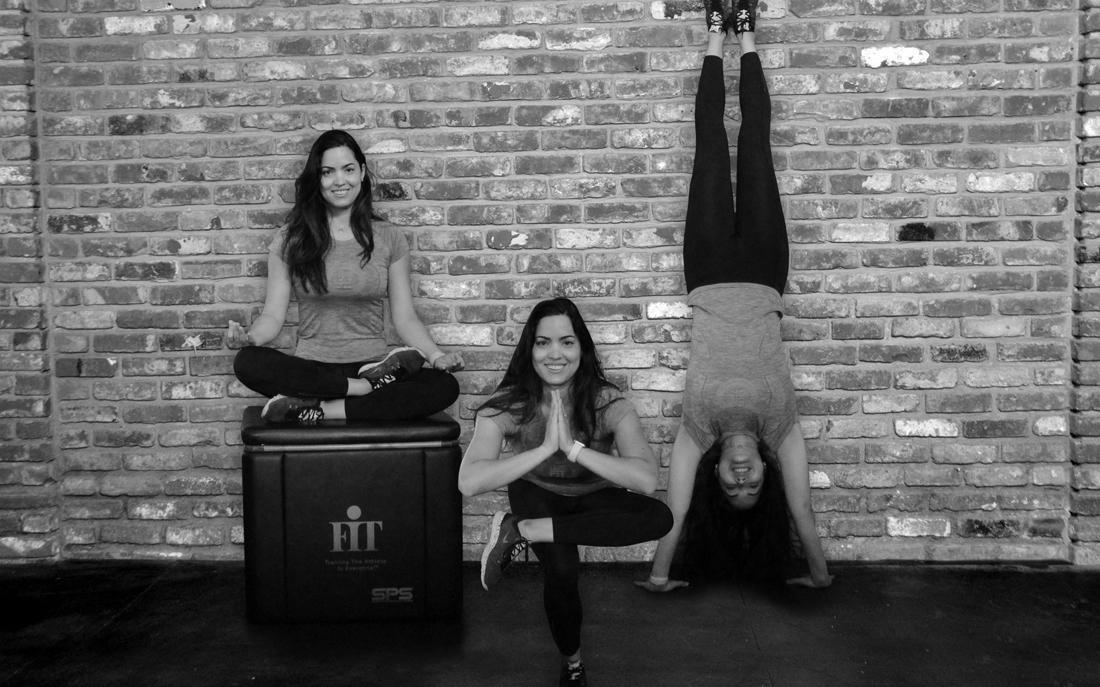
Angelo de la Cruz
Orthopedic Massage Therapist & Personal Trainer
Spirit Animal: Wolf-bear-dragon-unicorn beast
Contact
While studying biological sciences at Cal Poly SLO, it became clear that my health was suffering. I was always tired, I couldn’t sleep well, I had digestive issues, and my emotions would swing dramatically at times. The realization came that in order for me to enjoy life to its fullest, I had to get serious about improving the quality of my health.
Since then, I’ve studied with doctors, physical therapists, clinical nutritionists, physical trainers, bodyworkers, and top innovators in the field of health & wellness. Instead of chasing the symptoms of illness, the most effective approaches to well-being are those that work to eliminate things that degrade health AND instill lifestyle habits that allow the natural environment of our bodies and mind to operate as efficiently as possible. In this way, we can be lead lives with less pain & sickness.
My work aims to use the technology of the body to help you live a more vibrant & productive life.
Some of the things I have fun doing are Olympic Weightlifting, breakdancing, parkour & free-running, snowboarding, creating electronic music, digital art photography/ videography, competing in American Ninja Warrior (My competition run is here) & learning about quantum physics.
What I love about FiT: Uplifting, motivating, supportive
Favorite sport: Martial Arts, ninja warrior obstacle courses, break dancing
- Former Life Science Support Scientist at NASA Ames Research Center
- Certified High Performance Coach
- 2nd Degree Black Belt in Taekwondo
- CrossFit – Level 1 Certification
- USA Weightlifting Club Coach Certification
- Intrinsic Coach Certification – Life & Health Coaching
- BS Anatomy & Physiology
- American Massage Therapy Association – Professional Member
- Nationally Certified in Therapeutic Massage & Bodywork
- Certified Hendrickson Method Instructor
- Primal Reflex Release Instructor
- Certified Massage Therapist
- Certified Functional Diagnostic Nutrition Practitioner

Shaun Conness
- USAW Club Coach
- NASM Certified Trainer
- TPI Golf Fitness Instructor
- CHEK Practitioner Level 1
- CHEK Certified Golf Biomechanics Specialist

Jennifer Mulry
Personal Trainer
Spirit Animal: Bear
Contact
What I love about FiT: I love the family atmosphere at FiT and the collective effort to all be the healthiest version of ourselves.
Favorite Sport(s): Basketball & Swimming
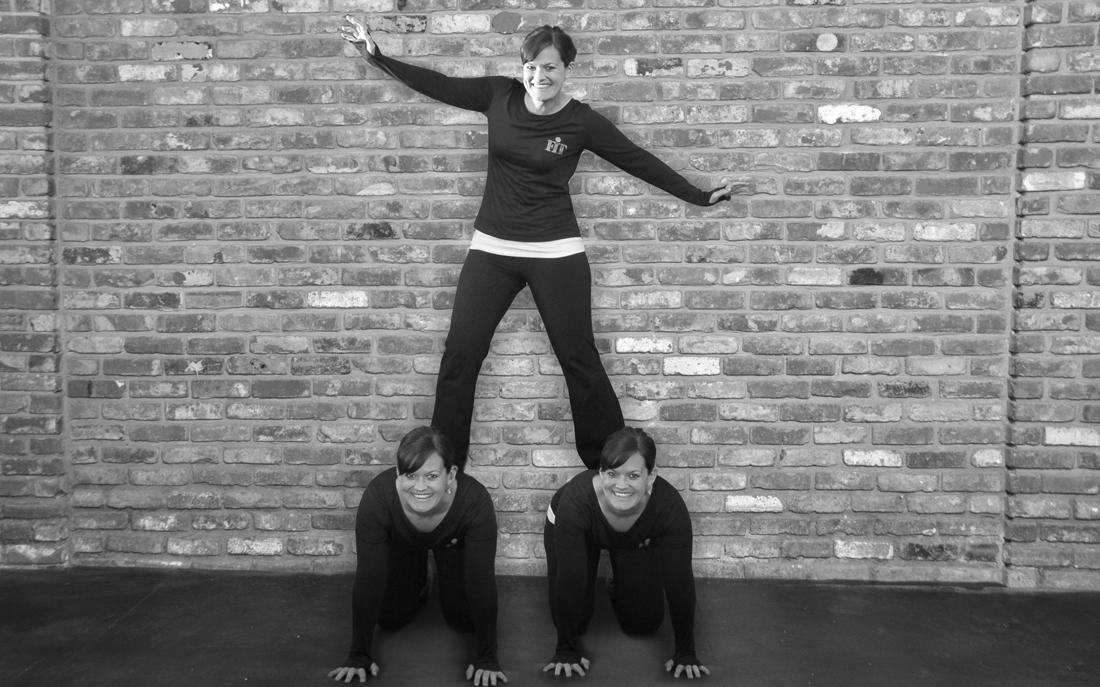
Jeff Samson
Trainer
Martial Arts Trainer
Assisted Stretch Practitioner
Spirit Animal: Blue Whale
Contact
What I love about FiT: Great space, staff, clients, ability to pursue my passions
Favorite sport: Jiujitsu


